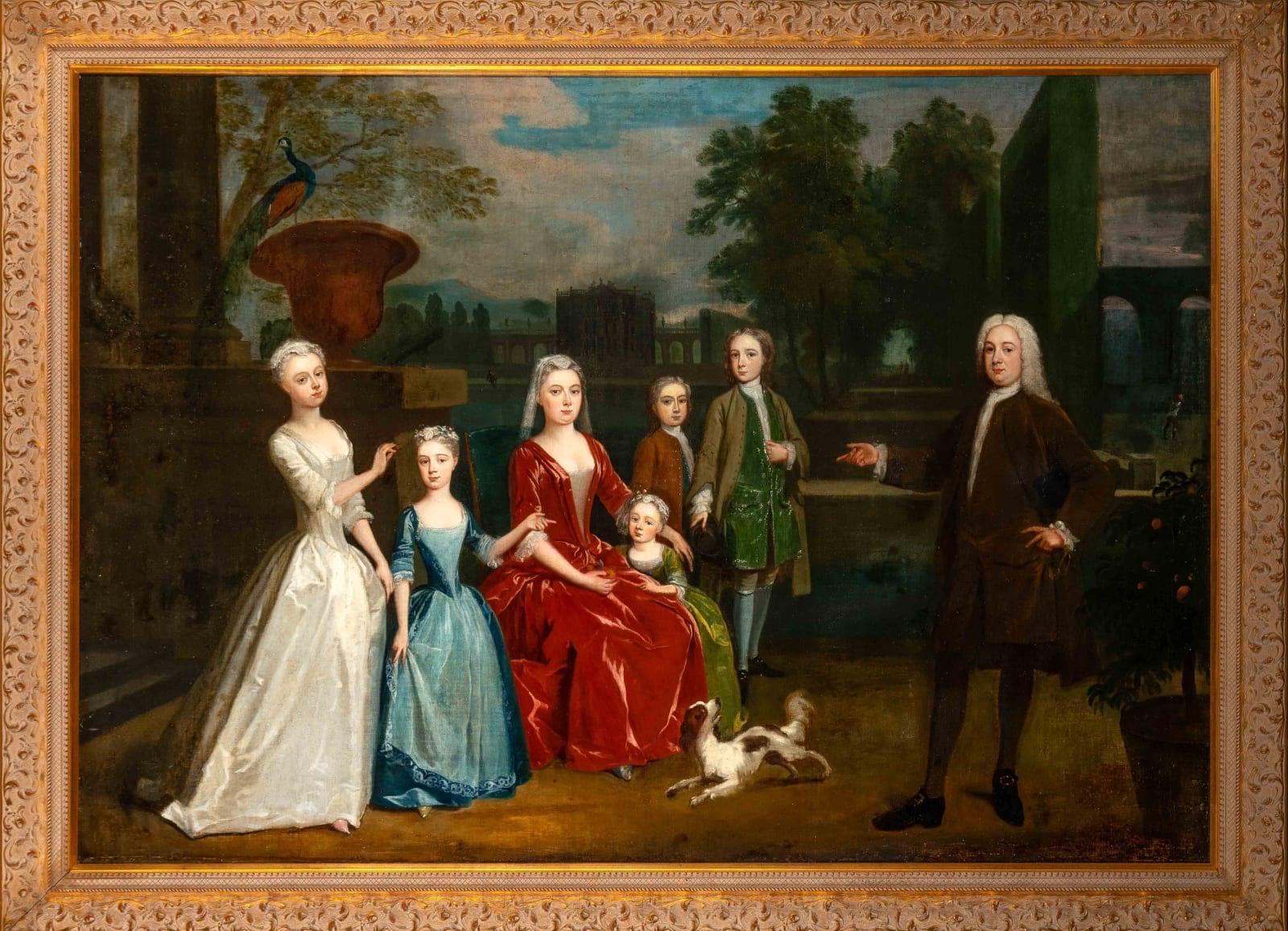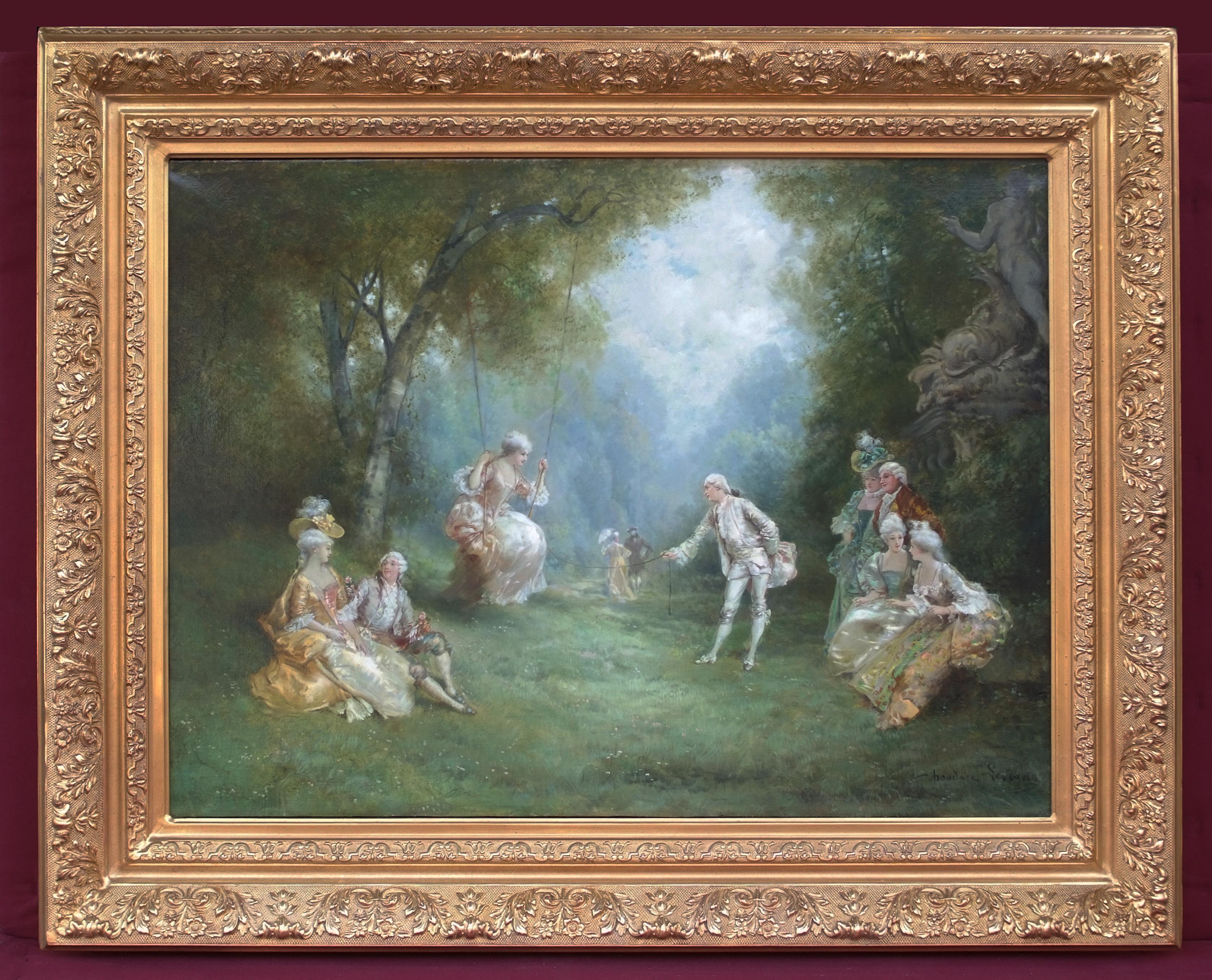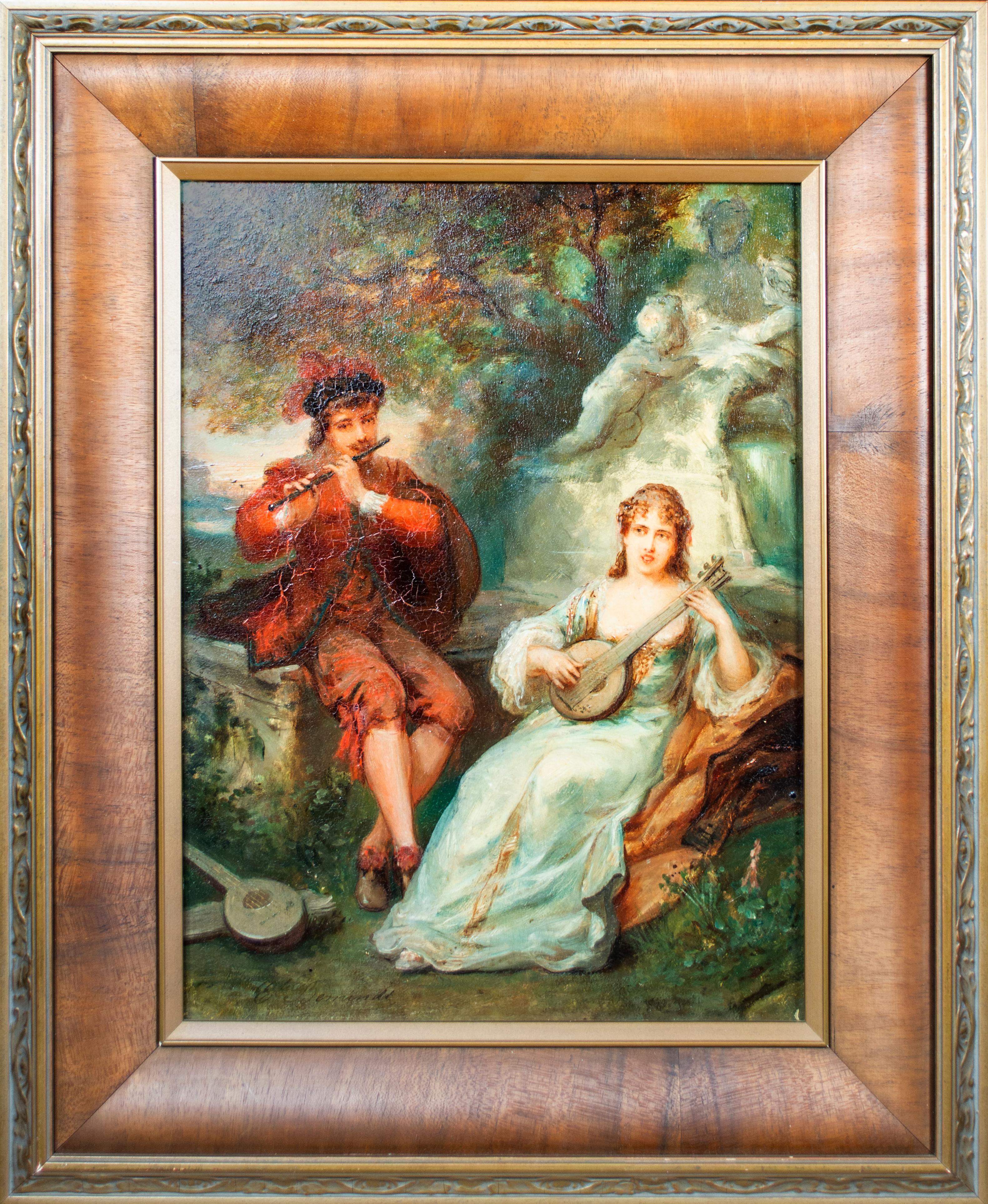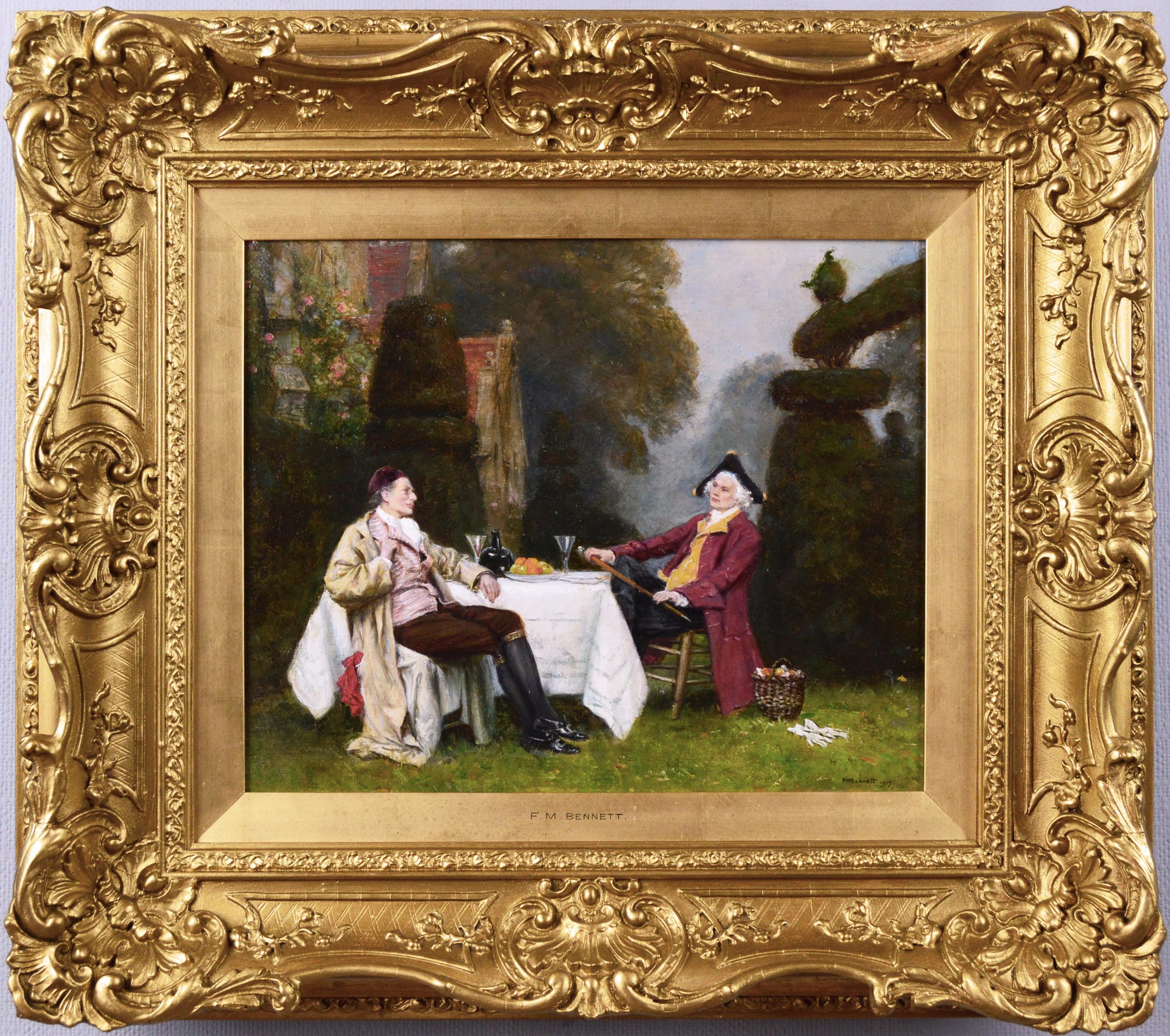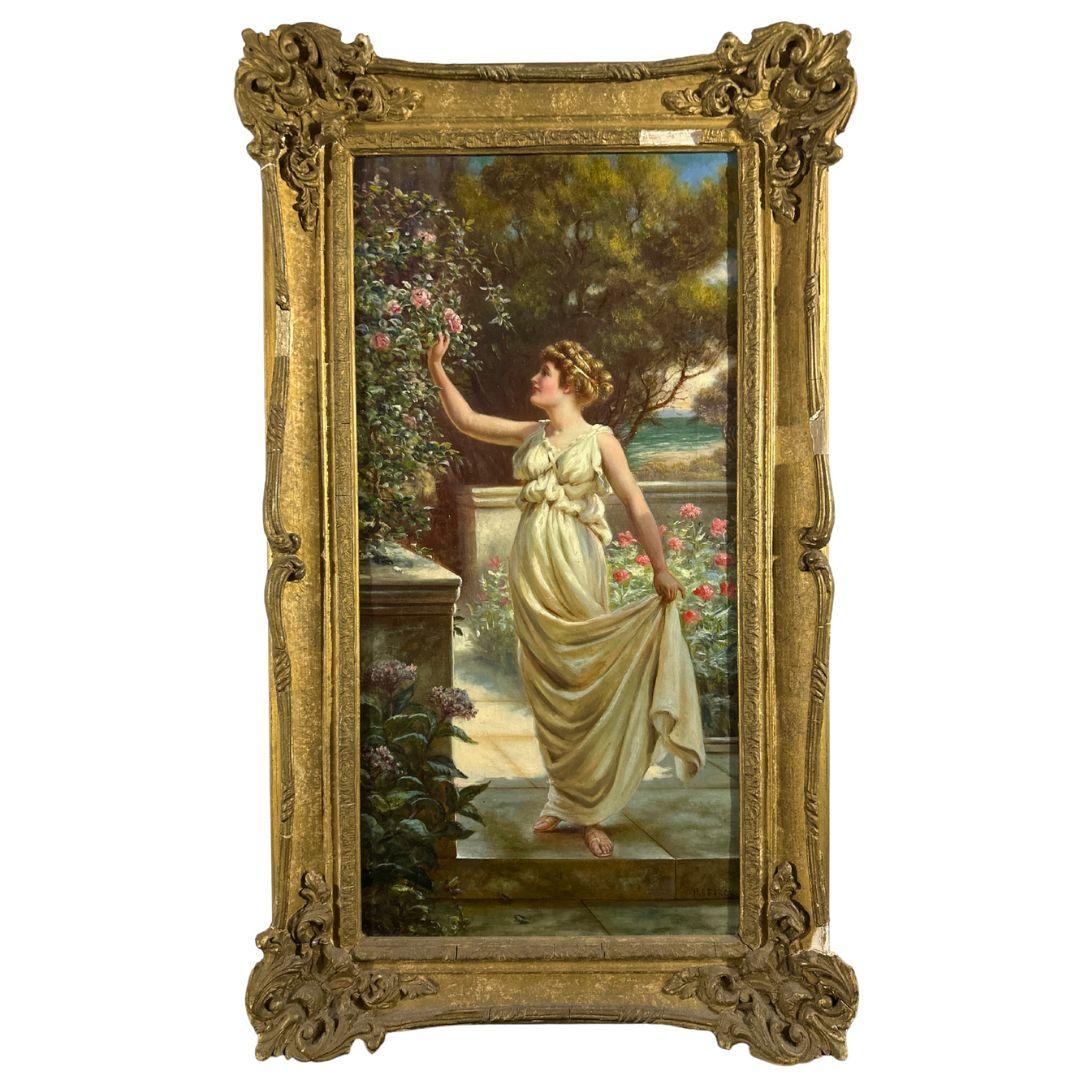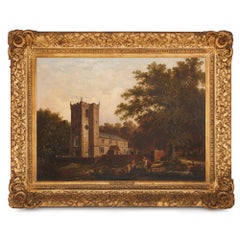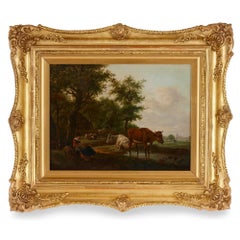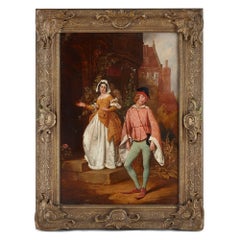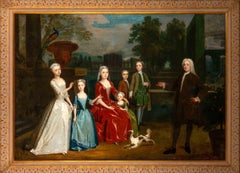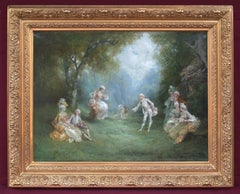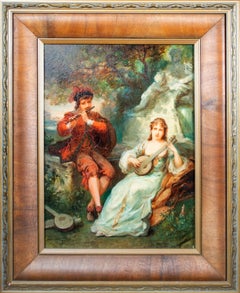Items Similar to Oil Painting of a Garden Scene from ‘The Heart of Midlothian’ by Leslie
Want more images or videos?
Request additional images or videos from the seller
1 of 10
Charles Robert Leslie R.A.Oil Painting of a Garden Scene from ‘The Heart of Midlothian’ by Lesliec. 1830
c. 1830
$10,290.71
£7,500
€8,777.15
CA$14,355.31
A$15,572.27
CHF 8,188.77
MX$189,483.06
NOK 102,372.82
SEK 96,550.14
DKK 65,532.68
About the Item
Oil painting of a garden scene from ‘The Heart of Midlothian’ by Leslie
English, c. 1830
Canvas: Height 30cm, width 25cm
Frame: Height 38.5cm, width 32.5cm, depth 3cm
This beautiful artwork was painted around 1830 by Charles Robert Leslie (1794-1859), a renowned English painter, especially known for his genre paintings.
The scene portrayed illustrates an event described by Sir Walter Scott in his 1818 novel ‘The Heart of Midlothian’. Scott tells the story of Jeanie Deans who travels to London to persuade Queen Caroline to release her wrongly imprisoned sister. The Duke of Argyll introduces Jeanie to the Queen on the grounds of Richmond Lodge. The Queen is highly impressed with the way Jeanie presents herself and allows for her sister to be released.
The painting in Mayfair Gallery’s collection depicts the scene when Jeanie Deans meets Queen Caroline. Deans is clothed in all black apart from the vivid red headscarf, while the Queen, her companion, and the Duke of Argyll are clothed in fashionable garments made from the best textiles. The light colours of the Queen's clothing magnificently stand out against the darker tones of the background and highlight her importance in the story.
The wonderfully carved giltwood frame is mounted with a plaque reading ‘INTERVIEW OF QUEEN CAROLINE WITH JEANIE DEANS IN RICHMOND PARK by C.R. LESLIE R.A.’.
Celebrating the works of a renowned artist and writer, this painting tells an interesting story with a deeper meaning.
- Creator:Charles Robert Leslie R.A. (1774 - 1859)
- Creation Year:c. 1830
- Dimensions:Height: 15.16 in (38.5 cm)Width: 12.8 in (32.5 cm)Depth: 1.19 in (3 cm)
- Medium:
- Period:
- Condition:
- Gallery Location:London, GB
- Reference Number:Seller: 174731stDibs: LU674313286612
About the Seller
5.0
Vetted Professional Seller
Every seller passes strict standards for authenticity and reliability
1stDibs seller since 2017
28 sales on 1stDibs
- ShippingRetrieving quote...Shipping from: London, United Kingdom
- Return Policy
Authenticity Guarantee
In the unlikely event there’s an issue with an item’s authenticity, contact us within 1 year for a full refund. DetailsMoney-Back Guarantee
If your item is not as described, is damaged in transit, or does not arrive, contact us within 7 days for a full refund. Details24-Hour Cancellation
You have a 24-hour grace period in which to reconsider your purchase, with no questions asked.Vetted Professional Sellers
Our world-class sellers must adhere to strict standards for service and quality, maintaining the integrity of our listings.Price-Match Guarantee
If you find that a seller listed the same item for a lower price elsewhere, we’ll match it.Trusted Global Delivery
Our best-in-class carrier network provides specialized shipping options worldwide, including custom delivery.More From This Seller
View All‘Petrarch’s First Sight of Laura’ Early 19th Century Oil Painting by O'Neil
Located in London, GB
‘Petrarch’s First Sight of Laura’ early 19th century oil painting by Henry Nelson O’Neil
British, c. 1840
Canvas: Height 129cm, width 176cm
Frame: Height 165cm, width 207cm, depth 12cm
Painted by a renowned Victorian artist, Henry Nelson O’Neil (British, 1817-1880) around 1840, this very fine oil on canvas depicts the first meeting of Petrarch and Laura in a Church in Avignon in 1327.
Petrarch (1304-1374) was an Italian Early Renaissance...
Category
Early 19th Century Renaissance Figurative Paintings
Materials
Canvas, Oil
'Chapel in the Woods', Oil on Canvas Painting by English School
Located in London, GB
'Chapel in the Woods', oil on canvas painting by English School
English, 1847
Canvas: Height 56cm, width 77cm, depth 2.5cm
Frame: Height 78cm, width 97cm, depth 9cm
This beautiful ...
Category
19th Century Academic Landscape Paintings
Materials
Canvas, Oil
Antique Dutch painting of countryside with figures and animals
Located in London, GB
This beautiful oil on panel painting represents an ideal landscape: figures recline by a tree, cows and sheep laze in the late afternoon light, and the...
Category
18th Century Landscape Paintings
Materials
Oil, Panel
Painting of The Merry Wives of Windsor attributed to John Calcott Horsley
By John Callcott Horsley
Located in London, GB
Painting of The Merry Wives of Windsor attributed to John Calcott Horsley
English, 19th Century
Frame: Height 97.5cm, width 74cm, depth 7cm
Panel: Height 78cm, width 54cm, depth 0.5c...
Category
19th Century Victorian Interior Paintings
Materials
Oil, Board
Painting of horses and farm animals by Herring the Younger
By John Frederick Herring Jr
Located in London, GB
Painting of horses and farm animals by Herring the Younger
British, 19th Century
Frame: Height 83cm, width 97cm
Canvas: Height 64cm, width 77cm
This charming painting is by John Fre...
Category
19th Century Landscape Paintings
Materials
Canvas, Oil
Oil painting of a Whitsuntide fair after Munnings
By Alfred Munnings
Located in London, GB
Oil painting of a Whitsuntide fair after Munnings
English, early 20th Century
Frame: Height 78cm, width 96cm, depth 5.5cm
Canvas: Height 50cm, width 70cm, depth 2cm
This fine oil pa...
Category
Early 19th Century Landscape Paintings
Materials
Canvas, Oil
You May Also Like
Fete Champetre - Garden Party - French 18thC figurative landscape oil painting
Located in Hagley, England
This charming 18th century French Old Master oil painting is attributed to circle of Joseph Frans Nollekens. Painted circa 1740 it is described as a fete champetre - a form of entertainment in the 18th century, taking the form of a garden party. They were often elegant affairs and became very popular in 18th French paintings. Antoine Watteau invented the genre, from around 1710 and they were also included as a category in the French Academy. In this painting, several well dressed figures are sat in the foreground by a fountain and statue, being entertained by a musician. Beyond, a wide avenue of trees leads towards a very grand country house with countryside beyond. There is superb detail in the figures and their colourful clothing. The brushwork in the trees and sky is also superb. This is a charming example of an 18th century fete champetre and of a French Old Master oil painting.
Provenance. Gloucester estate.
Condition. Oil on canvas. Image size 49 inches by 30 inches and in good condition.
Frame. Housed in a fine gilt frame, 56 inches by 37 inches and in good condition.
Josef Frans Nollekens or Joseph Frans Nollekens (1702–1748)[2] was a Flemish painter who was principally active in England where he is often referred to as "Old Nollekens" to distinguish him from his famous son, the sculptor Joseph Nollekens. He painted conversation pieces, galant companies and fêtes champêtres in the style of Watteau, genre scenes as well as portraits. He was also active as a picture restorer.
A fête champêtre was a form of entertainment in the 18th century, taking the form of a garden party. This form of entertainment was particularly practised by the French court, where in the Gardens of Versailles and elsewhere areas of the park were landscaped with follies, pavilions, and temples to accommodate such festivities. The term is a French expression, very literally translating as "party in the fields", meaning a "pastoral festival" or "country feast" and in theory was a simple form of entertainment, perhaps little more than a picnic or informal open air dancing. In practice, especially in the 18th century, the simplicity of the event was often contrived. A fête champêtre was often a very elegant form of entertainment involving on occasions whole orchestras hidden in trees, with guests sometimes in fancy dress. Such events became a popular subject in French 18th-century painting, representing a glamourized aristocratic form of pastoral, with "scenes of well dressed dalliance in a park setting". Antoine Watteau invented the genre, from around 1710, and is its best exponent, imitated by others such as Nicolas Lancret and Jean-Baptiste Pater...
Category
1740s Old Masters Landscape Paintings
Materials
Oil
$17,562 Sale Price
20% Off
18th century painting of the Dalbiac family in the gardens of a country house
By Charles Philips
Located in Bath, Somerset
The painting depicts James (Jacques) Dalbiac, his wife Louise (ne de la Porte) and their five children, James, Charles, Louise, Marianne and Martha in the ornamental gardens of a grand country estate.
The extensive gardens extend into the distance with gardeners working in the background and figures strolling through the avenues of trees. A peacock and peahen can be seen on the wall to the left and a potted orange tree to the right. Louise Dalbiac holds an orange taken from the orange tree, aluding to the family's faith and their loyalty to the protestant King William of Orange and their adopted country.
The Dalbiacs were wealthy London silk and velvet merchants of French Huguenot origin who had fled France at the end of the 17th century to escape persecution for their protestant faith. England offered safe refuge and their skills and industriousness allowed them to establish one of the most successful businesses in London's Spitalfields which became a new centre of the silk trade, effectively leading to the collapse of the once dominant French silk industry. Both sons, James and Charles followed their father and Uncle into the family business, successfully growing the family's fortune and each going on to own their own country estates.
A conversation piece is a genre of painting used to describe group portraits of families and friends, often depicted with their servants and family pets and set within an elegantly furnished interior or the garden of a grand country house. They were a celebration of the intimacy of family relations as well as a sign of status, property and the power of succession. The informality of conversation pieces grew popular in 18th century England, allowing the sitters to present themselves in a more relaxed pose, perhaps engaged in intellectual conversation or showing their talents or interests. In this present portrait, the Dalbiacs are shown richly dressed and and at leisure in a grand country house setting, conveying their success and cultural and social aspirations.
Charles Philips (c.1703–1747) was an English artist known for painting a number of portraits and conversation pieces for noble and Royal patrons in the mid-eighteenth century. He was the son of portrait painter Richard Philips...
Category
Early 18th Century Old Masters Portrait Paintings
Materials
Canvas, Oil
Gentry People in The Park in 18th century
By Theodore Levigne
Located in Saint-Ouen, FR
LEVIGNE Théodore (1848-1912)
"Genre scene in 18th century"
Oil on canvas signed low right
Old original frame
Dim canvas : 72 X 100 cm
Dim frame : 103 X 127 cm
LEVIGNE Théodore (1848...
Category
1880s Academic Figurative Paintings
Materials
Oil
19th century realist oil painting figurative man and woman outdoors garden
Located in Milwaukee, WI
Émile Bemindt was a French artist active between 1859 and 1872 and is best known for work in the style of the Rococo Revival: During the late nineteenth ...
Category
Late 19th Century Rococo Figurative Paintings
Materials
Oil, Board
Early 20th century genre oil painting of two gentlemen in a garden
By Frank Moss Bennett
Located in Nr Broadway, Worcestershire
Frank Moss Bennett
British, (1874-1952)
In the Garden
Oil on panel, signed & dated 1917
Image size: 11 inches x 13.5 inches
Size including frame: 20 inches x 22.5 inches
A charming genre scene of two gentlemen in 18th century costume in a garden by Frank Moss Bennett. The men are shown drinking wine and eating fruit at a linen covered table...
Category
Early 20th Century Victorian Figurative Paintings
Materials
Panel, Oil
"Walking Among the Backyard" 18th Century Antique Oil Painting on Canvas
Located in Jacksonville, FL
"Walking Among the Backyard" is a mesmerizing antique oil painting on canvas that transports viewers to the elegant world of 18th-century Europe. The artwork depicts a European lady ...
Category
19th Century Realist Figurative Paintings
Materials
Canvas, Oil

